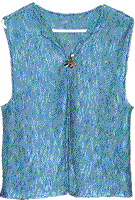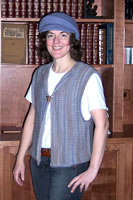Mirror Vest
Knitting completed Jan 18, 2004.This page has a pattern generator to create a pattern for a simple machine knit vest. It's a fairly easy generator to use, and a very easy pattern to knit. I've named the "Mirror Vest" because you mirror the shaping at 3 different points. (This is the machine knit page. The hand knit version is available.)
Features of this design:
- Cast on at center front. Sideways knit in one piece.
- Knit on a single bed knitting machine.
- Stockinette body. (You can modify this if you wish.)
- Crocheted chain stitch trim around the edges.
- Front closed with a decorative pin. (You could knit I-Cord or crochet chain stitch ties to close.)
- You can use default dimensions for various sizes, or enter your own to customize the shape.
Lucia Liljegren
Visit
the blog!
|
My site is supported by your annual $3 donation. Please click. |
|

